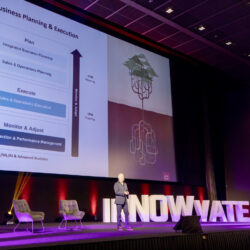Renewed supply chain supports business transformation at Philip Morris International

Five years ago, Philip Morris International (PMI) publicly announced its vision to deliver a smoke-free future, and since then has been leading a radical transformation of its business and the industry, based on new, smoke-free products. The existing supply chain developed into a more complex one, now including direct channels to adult consumers, a new ecosystem of suppliers and reverse logistics. To tackle the complexity, PMI set a single global control tower for end-to-end supply chain planning. In a webinar by Supply Chain Media and E2open, Anastasia Oplustil explains the starting point: a vision based on technology.
By Marcel te Lindert
In 2016, Philip Morris International announced a drastic decision. The cigarette manufacturer commited to deliver a smoke-free future as soon as possible, by replacing cigarettes with smoke-free alternatives for adults who would otherwise continue to smoke. “By the end of March 2021, our smoke-free products have been introduced to the market in 66 countries and they account for 28% of our total net revenues. Worldwide, approximately 14 million adults have already switched to smoke-free products and stopped smoking. By 2025, PMI’s goal is to reach at least 40 million users,” says Anastasia Oplustil (pictured), manager of supply chain strategy & results delivery at Philip Morris International.
From relatively stable to a more volatile demand pattern
The product and business transformation created a need for PMI to revisit its supply chain. For years, the company only supplied consumables, but now also added electronics and accessories to its supply chain. The relatively stable demand pattern gave way to a more volatile one. “How many adult smokers would switch to our smoke-free products? In which markets and at what pace? What accessories they would want? And how were we to link our forecast for devices to the forecast for consumables? To answer these questions, we knew we had to change our existing forecasting methods,” says Oplustil.
The upstream impact was also considerable. Whereas previously everything was produced in-house, the company now had to work with contract manufacturers for the production of the electronics. This made it harder than before to respond quickly to changes in demand. Oplustil: “With the new product, we have also introduced new business models. We now also sell our smoke-free products directly to adult users through our own online channels and stores. Increasing the number of sales channels added more complexity to the supply chain.”
New processes, systems and competences
The transformation led to diversification in the supply chain. The company now receives orders not only from large retailers and distributors, but also from individual consumers. They can order products directly from PMI and also send appliances back. In response, PMI developed a new approach to control the supply chain. “First of all we had to ensure real-time visibility in the supply chain, both upstream and downstream”, says Oplustil.
Oplustil also highlights the importance of data insights for supply chain management. This concerns data from points of sale, for example, but also from first- and second-line suppliers. “We share our forecasts with the suppliers and try to stick to them as closely as possible. But in case the forecast changes, we want insight into their production capacity and into the availability of critical components. This gives us insight into the flexibility we have to respond to changes in demand.”
Control tower for end-to-end planning
To address the new challenges, PMI started digitising and automating the supply chain. The goal: a ‘touchless’ forecasting and planning process in which the planners only have to deal with the exceptions. “In short: we needed new processes, systems and competences. For this we set up a new, central department for end-to-end supply chain planning for both electronic devices and consumables. This control tower houses the global activities of demand planning, supply planning, production planning and distribution planning.”
It is noteworthy that PMI took technology as the starting point in setting up this department. “Like many companies, we had built up a tradition of continuously improving our processes step by step. Now we have not taken the existing planning processes as our starting point, but the technological possibilities. What possibilities does it offer to set up a ‘touchless’ planning process? We have adapted the processes accordingly and ensured that the planners have the right skills to use this technology. It is this technology that does the planning. The planners only intervene when necessary.”
Technology as a starting point
Centralisation was a key success factor. Putting all planners together made the transformation much easier. “We started by drawing up standard processes and procedures for each product category. By doing so, we adhered to the mantra that there are no differences between markets. In other words, we developed one global template instead of separate templates for each market. This has resulted in a high degree of standardisation,” explains Oplustil. “In addition, we have set up our own supply chain academy to develop the right competencies. Only after going through this academy did the planners get their ‘license to operate’.”
Most of the technology comes from E2open, a leading supply chain software vendor. The foundation consists of a data layer in which all internal and external data sources are brought together. On that foundation, various apps are built that take care of certain planning processes.
Assistance in handling exceptions
”These apps are connected through a reporting layer to leverage all generated data for decision making”, which is a key input to integrated business planning (IBP). “Last year we started implementing this,” says Oplustil. “We also use all this data for reports and analyses. These help us to drive the IBP process and in making the right decisions.” On top of all this, PMI, in collaboration with E2open, has added a cognitive layer that supports planners even more in making decisions. “Soon, the planners will be assisted by technology also in how to handle the exceptions, for example using a decision tree.”
The results are enormous. Speed to market has quadrupled, while the planning cycle – from demand planning to production planning – has been reduced to 5 days. Fixed costs have been reduced by a quarter. “In addition, we are now able to introduce new products in multiple markets simultaneously. We couldn’t have done that before,” says Oplustil, who adds that the quality of the planning process has also improved. The forecast error in 2020 has decreased by 20% compared to 2019. The case fill rate is at 96% and 99% respectively for the electronic devices and accessories product groups.
Crucial partner for the business
Oplustil mentions several factors that made the difference for Philip Morris International. These include the centralisation, which enabled a significantly faster transformation, and technology, which laid the foundation for a vision of touchless planning. “In addition, we realised from the start that the role of the planner would change fundamentally. We needed a different mindset, where the planners trust the technology and the data. At the same time, the planners were given a more important role. Instead of crunching data, they have become a partner who challenges decisions. They are now a crucial partner for the business.”










